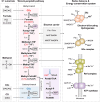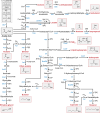Harnessing acetogenic bacteria for one-carbon valorization toward sustainable chemical production
- PMID: 39211478
- PMCID: PMC11353040
- DOI: 10.1039/d4cb00099d
Harnessing acetogenic bacteria for one-carbon valorization toward sustainable chemical production
Abstract
The pressing climate change issues have intensified the need for a rapid transition towards a bio-based circular carbon economy. Harnessing acetogenic bacteria as biocatalysts to convert C1 compounds such as CO2, CO, formate, or methanol into value-added multicarbon chemicals is a promising solution for both carbon capture and utilization, enabling sustainable and green chemical production. Recent advances in the metabolic engineering of acetogens have expanded the range of commodity chemicals and biofuels produced from C1 compounds. However, producing energy-demanding high-value chemicals on an industrial scale from C1 substrates remains challenging because of the inherent energetic limitations of acetogenic bacteria. Therefore, overcoming this hurdle is necessary to scale up the acetogenic C1 conversion process and realize a circular carbon economy. This review overviews the acetogenic bacteria and their potential as sustainable and green chemical production platforms. Recent efforts to address these challenges have focused on enhancing the ATP and redox availability of acetogens to improve their energetics and conversion performances. Furthermore, promising technologies that leverage low-cost, sustainable energy sources such as electricity and light are discussed to improve the sustainability of the overall process. Finally, we review emerging technologies that accelerate the development of high-performance acetogenic bacteria suitable for industrial-scale production and address the economic sustainability of acetogenic C1 conversion. Overall, harnessing acetogenic bacteria for C1 valorization offers a promising route toward sustainable and green chemical production, aligning with the circular economy concept.
This journal is © The Royal Society of Chemistry.
Conflict of interest statement
There are no conflicts to declare.
Figures





References
-
- C. Intergovernmental Panel on Climate, Climate Change 2021 – The Physical Science Basis: Working Group I Contribution to the Sixth Assessment Report of the Intergovernmental Panel on Climate Change, Cambridge University Press, Cambridge, 2023
-
- Schilling C. Weiss S. Nat. Biotechnol. 2021;60:9–11. - PubMed
Publication types
LinkOut - more resources
Full Text Sources
Molecular Biology Databases

